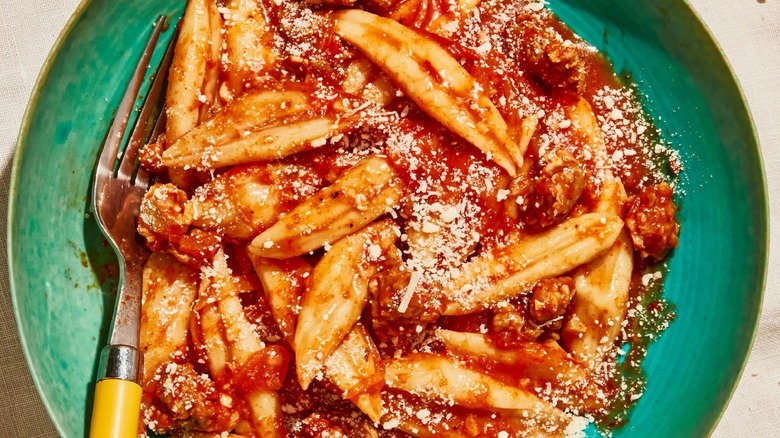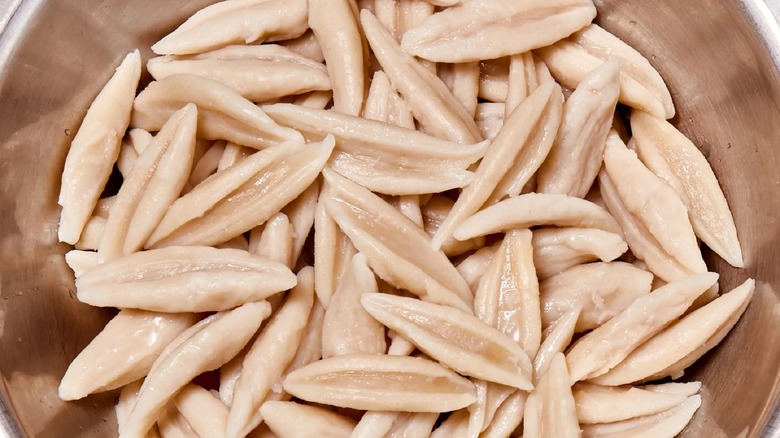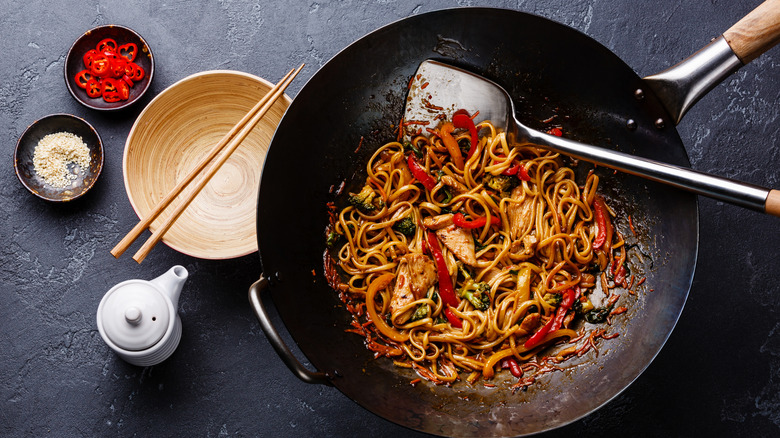Make Homemade Noodles In A Flash With The Scissor Cut Technique
The noodle is a world traveler, appearing in regional dishes in every corner of the globe. Seriously, trace your finger along a culinary map, and you're bound to discover another variation of this international food staple. Explore Asian noodles starting in Japan, with favorites including udon, soba, and ramen; move over to China for lo mein and mi fen; trek west for Italian pasta and German spätzle; and finally head west across the Atlantic Ocean for some good ol' American macaroni and cheese.
Several arguments can be made for why noodles are so popular, but one of the most convincing could be their convenience. A package of dry noodles is easy to procure, inexpensive, simple to prepare, and shelf-stable. Given these benefits, it's no surprise that most people buy their noodles instead of making pasta fresh from scratch. But this is a shame because homemade noodles can be such a joy to both prepare and eat, possessing a freshness, flavor, and chew that deliciously differentiates them from their dried counterparts.
Although the idea of making noodles at home may be intimidating, you might be relieved to know that you don't need an expensive specialty attachment for a fancy stand mixer — or even a big rolling pin. There are a lot of hacks for making pasta; thanks to the unbelievably simple scissor-cut technique, you can create plump, toothsome little noodles with minimal effort and only one ingredient.
The best noodle technique you've probably never heard of
The scissor-cut technique is the simplest and most effective way to make homemade noodles. From start to finish, the noodles can come together in less than 45 minutes. All you need is flour, water, and salt. When selecting your flour, all-purpose is fine, but if you're into experimentation, you can also do a half-and-half blend that mixes whole wheat with all-purpose.
The basic recipe for noodles — if you can even call it a recipe — requires three simple steps. First, combine flour and water in a 2:1 ratio of flour to water, and add a pinch of salt. Next, mix the ingredients in a bowl or food processor until they come together. Knead the dough then shape the dough into a ball, cover, and rest for 30 minutes. When the dough is finished resting, bring a pot of water to a rolling boil. Take a good pair of kitchen scissors and rub them with a bit of oil so the dough doesn't stick while cutting. Now, with dough in one hand and scissors in the other, cut the dough into even strips and allow the noodles to plop into the water gently. Cook them until they start to float, roughly five to six minutes depending on the density of your noodles. Strain, and, voilà, you've just made a tasty batch of chewy homemade noodles.
Amping up your scissor-cut noodles
Scissor-cut noodles can be cut to have a plumpness and toothsome bite, making them an accepting canvas for sauces, toppings, and other accouterments. They're typically heartier than average dried pasta, giving them the strength and density to stand up to sauces of different consistencies and flavor profiles. Although you can always buy a recommended jarred or prepackaged sauce, there are a lot of homemade varieties you can whip up quickly, with minimal effort.
Start simple by tossing your noodles with a blend of soy sauce, sesame oil, garlic, rice wine vinegar, and water, and finish with a topping of scallions or chile crisp. For something a little spicier, you can sauté diced kimchi with soy sauce, sesame oil, maple syrup, and water before adding in your fresh noodles. A homemade German spätzle can be another source of inspiration. Melt some butter in a pan, toss in the noodles, and cook until they're toasty and brown, then top them with fresh parsley, bread crumbs, and a crack of black pepper.
If you want to mimic penne or rigatoni, go with a homemade tomato sauce, a pesto, Bolognese, or broccoli rabe and sausage. In the mood for soup? Add scissors-cut noodles to a favorite broth, along with bok choy and sliced mushrooms, and top with a drizzle of soy sauce. Regardless of where you find inspiration for the sauce, you can't take a wrong turn when you start with fresh scissor-cut noodles you made yourself.


